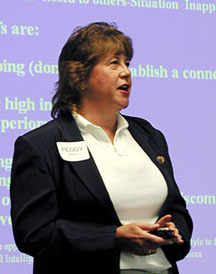

Making Conversation for Scientists
By Mika Ono
You can learn about genetics, data analysis, and scientific techniques in school and in the lab. But where can you learn to network?
A two-session workshop "Making Conversation for Scientists" at The Scripps Research Institute's La Jolla campus last month helped to provide this kind of education. Sponsored by the Scripps Research Society of Fellows and the Counseling and Postdoctoral Services Department, the seminars covered the basics.
"In general, social skills have been in decline," said speaker Peggy Wallace, who has worked as an attorney, stock broker, and fundraiser. "The practice of being 'front-porch friendly'—in essence, chatting with your neighbors—is rare these days. These skills aren't being passed on."
According to Wallace, at the heart of these social interactions is giving another person your complete attention—without preconceptions or judgment—even if only for a short time. In networking situations, the goal is to extend this interaction so it evolves into an exchange that is both personal and memorable.
In conversation, Wallace recommends beginning with the general, then moving to specifics. Particularly useful in beginning a conversation are topics relating to location. She suggests remarks such as, "Isn't this setting great?" "Did you have a long drive?" "Where are you coming from?" "What brings you here today?" "What do you think of the food?" Be prepared with brief remarks on the subject as a way to draw the other person out.
Knowledge of a few current issues can also help the conversation flow—movies, the price of gas, recent events. "Be well read," Wallace advised. "Listen to NPR. Even a little information can help. That way, when you arrive at events you are prepared with a few topics to discuss."
While active listening is important, so is self-disclosure. Setting an example of being personal helps make a connection and sets the stage for conversing about topics closer to home—work, family, hobbies, travel plans—where you may find meaningful common ground.
One member of the audience commented that she has had success establishing connections with others at scientific conferences by talking about the program. For scientists, the workshop participants seemed to agree, science is a great topic. Unlike some other professions (sales, accounting), scientists seem to relish talking about their work.
Wallace emphasized the importance of body language in all social situations, as people will read into seemingly small non-verbal cues. She acknowledged that this poses unique challenges for those from other cultures. Standards for personal space and eye contact, for example, vary from country to country. "In some cultures, a lot of eye contact is considered threatening or impolite," she said. "In America, however, it is critical in showing interest. Studies have shown that in the United States a listener looks at a speaker about 90 percent of the time. A speaker looks at the listener about 50 percent of the time. That's a lot of eye contact."
But Wallace's most serious caution to workshop participants was to avoid conveying an impression of arrogance. "Before I came here today, I talked to six potential employers of scientists from Scripps," she reported. "They all said one of the biggest turnoffs in a job candidate is arrogance."
While an attitude of self-confidence helps include and respect other people, arrogance distances them. "Patronizing and acting superior is off-putting," she noted. "You want to make sure you are placing yourself on equal footing with the person you are talking with, not above or below."
Throughout the workshops, participants received many other practical tips. These included:
• Place your name tag on the right side of your body, just below your collar bone. This is where it is easiest for others to read.
• A handshake should last about to the count of three. If someone else holds longer than this, give his or her hand a little squeeze and let go.
• In general, stand about 1 1/2 to 4 feet from a person with whom you are speaking—about a handshake away. Be flexible, though, so you can adapt to people from other cultures who might feel more comfortable closer or further apart.
• Smile. It puts people at ease.
• If you have a foreign accent, assume it is charming. If you are hard to understand, work on your speaking skills.
• Before a job interview, chat with the receptionist or assistant. His/her tone when announcing you can make a difference.
• In networking situations, remember that everyone is there to meet other people. (It's not just you.)
• At a networking event, the best place in a room to start a conversation is near the food.
• Pay attention to people's feet when deciding whether or not to join a conversation. If the participants' feet point out, it can be a sign they are receptive to others joining in.
• Business cards are invaluable in networking situations. Have yours readily available and be sure to ask others for theirs.
• Look for opportunities to help other people achieve their goals. This is a generous and effective way to establish contact.
• If you make a social gaffe, realize that it happens to everybody. Acknowledge the mistake and move on.
• When ending a conversation, let the person you have been speaking with know, in the moment, that you enjoyed your time together. Give details, and summarize conversation topics. Don't be afraid to say, 'I enjoyed our conversation about... and will get back in touch soon.'" Then do as promised, and follow up promptly.
• A thank you note will set you apart from the crowd.
• Keep socializing. Practice and you will get better at it.
For more information on the sponsors of the event, see the Scripps Research Society of Fellows web page and Scripps Research Postdoctoral Services web page. For more information on Wallace and her seminars, see the Making Conversation web site.
Send comments to: mikaono[at]scripps.edu

Speaker Peggy Wallace gets down to the specifics of meeting and greeting. Photo by Kevin Fung.
